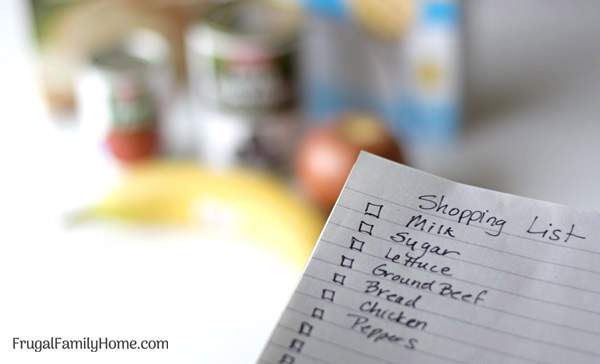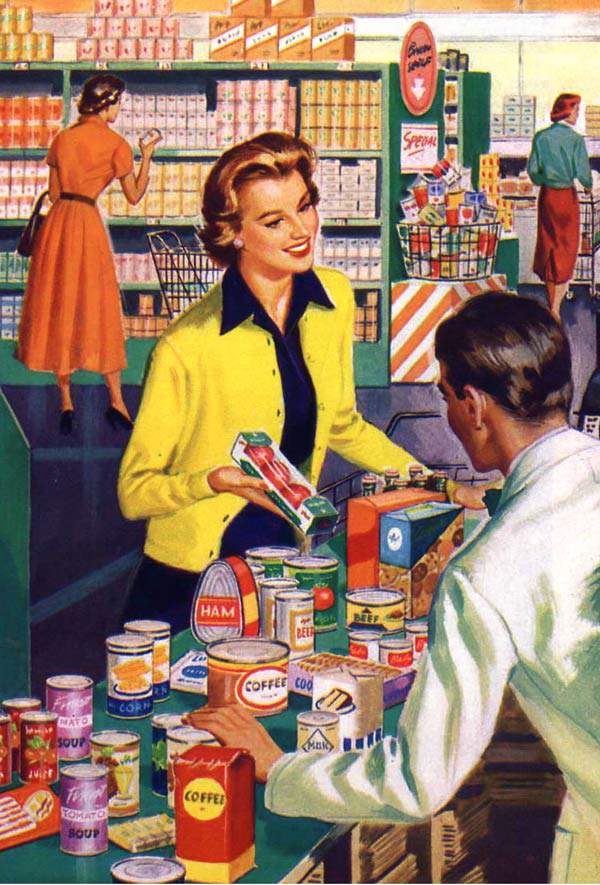12 Remarkable Tips to Save on Groceries
Inside: With grocery prices creeping up higher you can use all the help you can get to keep your grocery budget low. Try these 12 tips to help you save on groceries each time you shop.
Prices of food sure have been creeping up. It’s not only packaged food prices that have increased but the price of fruit, vegetables, and meat have too. It can be frustrating to see how few groceries you get for the amount you pay.
But what can you do, you have to eat and so you have to spend more right? With these tips below you can take control of what you spend on groceries each week. You might need to change how you shop or where you shop but you can save on groceries too.

I was looking at the USDA’s cost of food plan reports for how much a family of 4 like ours could be spending a month on groceries on their thrifty plan. I figured our family on the thrifty food plan could spend $1035 a month groceries. So how do we get by on half of that and still have all we need to eat and enough to share with others?
I employ these tips I’m sharing with you today. You can cut your grocery bill and have more money to save or to share with others or to pay down debt. It does take a little planning and maybe changing your shopping habit, but it can be done.
12 Ways to Save On Groceries
1. Look for Markdowns Every Time You Shop
Be sure to stop by the markdowns or clearance aisle at the store each time you shop. There are usually great buys in the meat department, the produce department, the dairy department, and on baked items.
But be sure to look at the prices, especially on meat. Often the meat that is marked down is more expensive cuts of meat. Even if it’s 30 to 50 percent off it still might be more per pound than the meat that is on sale that week. Shop the meat clearance but do so cautiously.
2. Shop More Than One Store
If you shop one store and only one store each week, you’ll end up paying more money overall. If you take the time to shop more than one store and pick up the best deals at each you can save more money each week.
I usually pick two to three stores to shop each week. I choose which store to shop by which items are on sale and which items I need to stock up on.
I’ve been known to shop more than three stores if there are some really good deals to be had. I stop when I’m close by one of the stores with the sale items while I’m doing other errands. So I’m not spending extra on gas.
When you shop the best deals at each store each week you can build a stockpile of inexpensive food so you won’t have to pay full price.
3. Be Quick in the Store
I’ve read the longer you are in the store, the more you’ll spend. Try to keep your shopping at a good pace and keep moving quickly. The less time you spend in the store the less you’ll spend at the store.
If you find it hard to keep moving try wearing earbuds and listening to upbeat music as you shop. It will keep you going at a good pace, much quicker than the slower music played in most stores.
4. Be Flexible on Brands
Don’t be brand loyal. Be willing to try a different brand when it’s on sale or try the store brands. The store brands are usually a better buy even without coupons over the same brand product.
If you do prefer a certain brand, be sure to use coupons when they are available, match the coupons with a sale and stock up when you find a great deal to save the most.
5. Plan Your Menu with What You Have on Hand
To save the most it’s best to plan your meals with what you have in your stockpile and what’s on sale. When I menu plan, I’ll look through the pantry, freezer, and cupboards first to see what we have and plan as many meals with those items.
Then I look at what is on sale to add to my stockpile. Using this method I keep my stockpile rotated by using it regularly and I’m constantly restocking when items are on sale instead of paying full price.

6. Don’t be Ridge at Sticking to Your List
I do recommend shopping with a list but don’t be too ridge at sticking to it. If you find a great deal on an item be willing to switch your menu plan to save the most money.
If you’re planning on making BBQ chicken with chicken breast or thighs but you find whole chicken on a great sale. Switch to making a full roasted chicken and skip the BBQ chicken for that week. You’ll get to take advantage of a great deal and you’ll also get more variety in your meals.
7. Don’t Be Afraid to Put an Item Back
Sometimes you succumb to temptation and pick up an item that’s not on sale or just looks good. Then you get to the check stand and think you can really live without it.
Don’t feel bad about putting it back or telling the cashier you’ve changed your mind. It’s better for your wallet to leave it at the store than take home an item you’re really not going to enjoy or want.
8. Shop with Cash
If you have trouble sticking to a grocery budget, start shopping with cash. It will help you stick to your list and keep you from overspending. I’ve been shopping with cash for groceries for years now.
I’ll make my list and guesstimate about how much I need to for each item and write the price down on my list. Then when I’m shopping I can see if I’m staying within budget without having to calculate each item. I only need to make sure each item is close to the cost I estimated.
I always have a few extra dollar in case I find a great deal I want to stock up on. It does take a little getting used to shopping with cash, but it does make sticking to a set amount much easier.
9. Check Unit Prices
With so many different sizes offered at the store, it’s hard to tell which one is the best buy. You don’t want to have to stand and calculate each item to find the best deal, that’s where comparing price per unit comes in.
On each price marker on the shelf, there is usually a price per unit. You can easily compare the unit prices between different sized items when you look for the price per unit. You might be surprised to find a smaller package might be a much better deal than a bigger one.
Before you decide on which items to buy be sure to compare the price per unit. This works most of the time but I’ve found at some stores the tag will only give the price for the whole items instead of by the pound or ounce. If you run into this problem you’ll need to calculate it for yourself.
To calculate the price per ounce or pound, take the total price and divide by the amount, such as total ounces or total weight to get the price per unit.
Bonus Tip, be sure to check the price per pound on meat packages. I’ve often found errors on the packages where the posted price is lower than the price on the package. It’s easy to miss and you could end up paying a lot more per pound than you expected.

10. Be Alert When Checking Out
I know it’s easy to check out while you are checking out at the register. You’re just so happy to be done shopping and getting close to going home. But if you don’t pay attention you could end up paying more.
It’s nice to be friendly with the cashier, but stay alert and watch what prices are coming up. If an item rings up higher than you expected ask about it. If you write prices on your shopping list like I do you’ll know how much your total should be if it’s higher be sure to look over your receipt right away.
I’ve caught quite a few errors in the past when I wasn’t given the sale price because it hadn’t been updated yet on the first day of the sale. Or an item didn’t scan at the right price. At some stores, if the price doesn’t scan correctly, you’ll get it free. Be sure to check your store’s policy.
11. Shop Discount Grocery Stores
I know at first it might seem weird to shop a discount or closeout grocery store. They don’t have all the item you want, they might be small and unorganized at times. But if you are willing to shop them you can save more over the retail grocery store.
But like any other store you need to know what a good price is. I’ve seen the same item priced higher at the discount grocery store than it is at the local retail store. You need to know your prices no matter what store you’re shopping at.
12. Don’t Throw Away Food
Buy what you’ll use and use what you buy. It’s not a great deal if it wilts and goes limp in the refrigerator and needs to be thrown out. Purchase what you’ll use and be sure to use it. With perishable items, if you find a great deal make sure you have a plan to use it up, or preserve it before it goes bad.

These 12 ways to save on groceries can help you to save more money each week. Even if you only use a few you’ll be able to save quite a bit of money.
Some of the links in this post are my affiliate links. When you purchase through them I can make a little money at no extra cost to you. Thanks for your support in this way.

Great tips, Shelly! We try not to spend too much time in the grocery store or just have my husband shop alone because we often spend more if the kids are along. 🙂